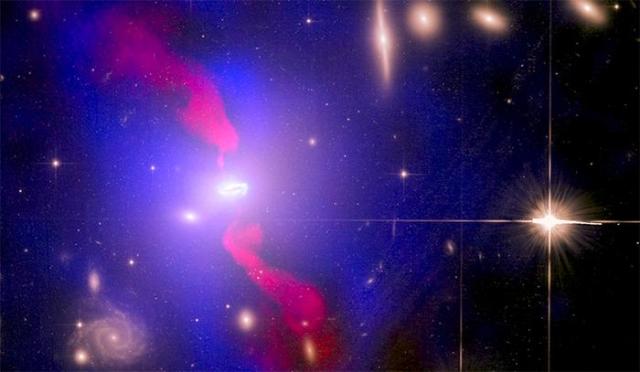Aug 7 2015
A Yale University astronomer has helped untangle the cosmic knots of stars at the center of giant, elliptical galaxies.
 This is a composite image of the Hydra Galaxy Cluster, including a look at the hot atmosphere of plasma that pervades the cluster, an ultraviolet image of young stars swirling, an optical image of the elliptical galaxy at the heart of the cluster, and a radio image of jets of relativistic plasma.
This is a composite image of the Hydra Galaxy Cluster, including a look at the hot atmosphere of plasma that pervades the cluster, an ultraviolet image of young stars swirling, an optical image of the elliptical galaxy at the heart of the cluster, and a radio image of jets of relativistic plasma.
Two studies, one led by Yale's Grant Tremblay and other led by Michigan State University researcher Megan Donahue, are providing new information about why the universe's largest elliptical galaxies ratchet down their star production despite having plenty of available star-making material. Tremblay's paper appeared in the Monthly Notices of the Royal Astronomical Society; Donahue's paper appeared in the Astrophysical Journal.
Elliptical galaxies, named for their elliptical shape, are the most common galaxies in the universe. In some of the largest elliptical galaxies, stars continue to develop along the jets of active black holes -- but only at a moderate rate.
Using data collected by space telescopes, including the Hubble, and from observatories on the ground, the researchers detect a self-regulating cycle of star births within elliptical galaxies. Jets shooting out of a galaxy's center control the rate at which surrounding gas cools and falls into the galaxy, almost like raindrops.
"The 'raindrops' eventually cool enough to become star-forming clouds of cold molecular gas, and the unique, far ultraviolet capabilities of Hubble allowed us to directly observe these 'showers' of star formation," said Tremblay, who is a NASA Einstein Fellow at Yale. "We know that these showers are linked to the jets because they're found in filaments and tendrils that wrap around the jets or hug the edges of giant bubbles that the jets have inflated, and they end up making a swirling 'puddle' of star-forming gas around the central black hole." Tremblay's work focused on elliptical galaxies in the nearby universe, while Donahue's team looked at galaxies in the more distant universe. Their results indicate that galactic collisions and other extreme cosmic events are not always necessary for the creation of showers of new stars.